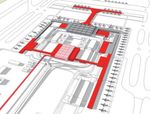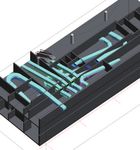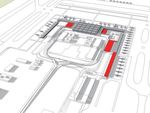Amd.sigma - The power of BIM in conceptual Airport Planning
←
→
Page content transcription
If your browser does not render page correctly, please read the page content below
amd.sigma I 07/2019
BIM is set to transform the planning landscape. With Four clear advantages of BIM
more and more countries committing to the soft-
Airports are fascinating and complex buildings. They are the fruition of a
ware, BIM will mean new laws and disruptive shifts network of organisational, financial, political and social vectors – ideally
in the work of planners. We discuss the benefits and structured around a vision and a strategy. But many times, unfortunately,
this is not the case. There tends to be a culture of short-termism around
pitfalls – as well as our own strategies for working big built assets, which often represent a cumulative history of quick fixes to
with this next-generation modelling solution. immediate problems. Over time, the big picture gets lost.
The use of building information modelling (BIM) is probably the most si- Our goal is to provide tangible visions which support our clients in making
gnificant development in the architecture, engineering and construction informed decisions. As such, there are four major advantages we see in BIM.
(AEC) industry in the past 15 years. Since traditional computer-aided de-
sign (CAD) tools already transformed the work of planners back in the 1. Managing complexity.
1990s, it is only logical to ask what BIM is now adding to the big picture. Considering the wealth of information that goes into airports – surveys,
The short answer is that while traditional CAD tools are used for drafting, existing facilities, future projects – our central models allow us to record
BIM encompasses even more facets: it is (at least) three-dimensional and and manage such diverse data in a very clear and reliable way. This first
offers an almost infinite array of tools to structure data in a digital model. step is vital to truly evaluate the asset. Complex requirements are precisely
Beyond this extra depth, it is a collaboration software – or a central tool what led planners at Heathrow Airport to pioneer the use of RUCAPS, the
that planners can use to work on the same model. This single point of predecessor of BIM, in 1986.
truth enhances communication among specialists on the one hand and
improves certainty regarding coordination and costs on the other. 2. Improved and enhanced communication.
The centralized structure of BIM enables our team to work simultaneously
Given these advantages, clients and contractors often see BIM as a risk on the same model, therefore decreasing the chances of mistakes arising
mitigation tool and a solution that focuses on construction and the coor- from (mis)communication between team members. The interaction from/to
dination of specialists – something that is usually outside of our scope. our BIM models has also proven to be quite valuable for our usual partners,
So why are we using it at amd.sigma? That’s the question we’ll be ex- whether they are planning airside or baggage handling systems, or for pro-
ploring here. ducing high-quality renderings.
2amd.sigma I 07/2019
3. Visualisation. Different scopes, one tool
Within the usually very short time frames we have to present scenarios to
decision makers, the mix of 2D conventional graphics (plans, sections) with As strategic advisers, we usually cover projects ranging from masterplans
3D views that is available with BIM streamlines the communication of each to building concept development. Navigating such complex projects is as
alternative. During discussions about a plan or section, misunderstandings fascinating as it is hard. To deal with complexity in our work and mitigate
can arise among even the most experienced architects and engineers. This inherent uncertainties, we operate between two major lines of action: the
problem is compounded when other specialists (e.g. investors and mana- expertise of our team on one hand and a systematic tool such as BIM on the
gers) join the conversation. And with a masterplan, where the scale is quite other. Open and systematic dialogue between these 2 vectors streamlines
unfamiliar to most people and highly abstract, the challenge of visualisation the added value for our clients, as we will see in the examples below.
becomes even more evident.
4. Depth of information.
With BIM, the additional fourth dimension of structured data (net/gross floor
areas, phasing, cost estimation and design options) provides a systematic
foundation for stakeholders to get a feel for each scenario. Whether we are
dealing with a macro-scale project for an airport city or planning a detailed
user requirements specification, we use BIM’s parametric tools to extract
the relevant data for each project and/or stakeholder.
Image 1. MASTERPLAN – BER 2040. The
3D models above were established as the
basis not only to visualise the development
of the BER Campus over time but also to
extract data to feed the CAPEX calculation.
3amd.sigma I 07/2019
Image 3. Building layout planning. For this model, alternative options were developed and itera-
tively discussed with the clients, with BIM models used as the basis for visualisation and data ext-
raction. This approach helped us quickly convey the building concept and flows, supported by live
key data such as gross floor area, net floor area (i.e. floor space per user) and processing num-
bers (check-in, security lines, baggage claim length/number and passport control, for example).
Image 2. Airport city development. For the development of this airport city, different urban
concepts were discussed with the client, with variations revolving around parameters such as
gross floor area, building usage ratios, soil types (hardscape vs softscape) and CAPEX calcu-
lation, all within the same model.
Image 4. Improved collaboration between stakeholders. These images exemplify the integrati-
on of the complex geometries for a baggage handling system (BHS) and allow the identification
of bottlenecks and clashes, making the project development more agile.
4amd.sigma I 07/2019
CAD to BIM: a seamless transition? (even in legal terms). Other markets are still testing or have yet to adopt.
Nevertheless, we are now witnessing pressure from both the market and
As one might expect, the switch to an entirely new visualisation and collabo- legislators. Germany, for example, has committed to a mandatory BIM re-
ration method also involves a number of challenges. For teams, the impact quirement for all infrastructure and large-scale projects by 2020.
tends to be very high, a fact which demands heavy internal investments.
In our experience, BIM requires an unusually deep dive into detailed con- Although the current scope of our activities is categorised as a preparation
siderations during early concept design stages. At the moment, our team stage, i.e. we support the client prior to all the official approval and permits
mitigates this demand for early depth with two strategies. One is to start processes, we see BIM as a potentially valuable model and basis for the
with a minimum set-up of a small number of elements used for each mo- official planning stages that follow. And obviously, we want to be the early
del. After identifying the brick-and-mortar of our usual scope, we develop a birds when this change takes effect.
working template that prevents team members from getting distracted and
losing time on overly detailed modelling. Our second strategy is to take a
step back and do more planning by free-hand sketching before we jump into
the software. Because BIM software offers little leeway in how models can
be structured and oriented, we are obliged to plan before building the model.
On the whole, the shift from traditional CAD to BIM is not an easy change.
Having gone through this myself a few years ago, the frustration needs to
be fought. Personally, it helps me to remind myself of the added value it Pedro Oliveira is Senior Consultant at amd.sigma and has over
allows us to offer our clients. At amd.sigma we have implemented regular 10 years of experience as an architect. He is amd.sigma´s ex-
in-house training for our staff which has been in place for almost one year. pert for Autodesk revit BIM software.
The results are quite satisfying – especially considering the heterogeneous email: oliveira@airport-dm.com
backgrounds of our staff and the learning curve for each team member.
amd.sigma is a German consulting firm based in Berlin that
specialises in strategic airport development. amd.sigma has
External signs and future commitments worked on projects for all major German airports as well as for
major international airports in Europe, Russia, the Middle East,
The current status of BIM varies quite widely around the world. In the UK, North- Middle- and South America.
USA, and Australia, its adoption has already reached a very mature stage website: www.airport-dm.com
5You can also read

























































